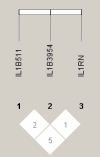Variable number of tandem repeat polymorphisms of the interleukin-1 receptor antagonist gene IL-1RN: a novel association with the athlete status
- PMID: 20175886
- PMCID: PMC2837019
- DOI: 10.1186/1471-2350-11-29
Variable number of tandem repeat polymorphisms of the interleukin-1 receptor antagonist gene IL-1RN: a novel association with the athlete status
Abstract
Background: The interleukin-1 (IL-1) family of cytokines is involved in the inflammatory and repair reactions of skeletal muscle during and after exercise. Specifically, plasma levels of the IL-1 receptor antagonist (IL-1ra) increase dramatically after intense exercise, and accumulating evidence points to an effect of genetic polymorphisms on athletic phenotypes. Therefore, the IL-1 family cytokine genes are plausible candidate genes for athleticism. We explored whether IL-1 polymorphisms are associated with athlete status in European subjects.
Methods: Genomic DNA was obtained from 205 (53 professional and 152 competitive non-professional) Italian athletes and 458 non-athlete controls. Two diallelic polymorphisms in the IL-1beta gene (IL-1B) at -511 and +3954 positions, and a variable number tandem repeats (VNTR) in intron 2 of the IL-1ra gene (IL-1RN) were assessed.
Results: We found a 2-fold higher frequency of the IL-1RN 1/2 genotype in athletes compared to non-athlete controls (OR = 1.93, 95% CI = 1.37-2.74, 41.0% vs. 26.4%), and a lower frequency of the 1/1 genotype (OR = 0.55, 95% CI = 0.40-0.77, 43.9% vs. 58.5%). Frequency of the IL-1RN 2/2 genotype did not differ between groups. No significant differences between athletes and controls were found for either -511 or +3954 IL-1B polymorphisms. However, the haplotype (-511)C-(+3954)T-(VNTR)2 was 3-fold more frequent in athletes than in non-athletes (OR = 3.02, 95% CI = 1.16-7.87). Interestingly, the IL-1RN 1/2 genotype was more frequent in professional than in non-professional athletes (OR = 1.92, 95% CI = 1.02-3.61, 52.8% vs. 36.8%).
Conclusions: Our study found that variants at the IL-1ra gene associate with athletic status. This confirms the crucial role that cytokine IL-1ra plays in human physical exercise. The VNTR IL-1RN polymorphism may have implications for muscle health, performance, and/or recovery capacities. Further studies are needed to assess these specific issues. As VNTR IL-1RN polymorphism is implicated in several disease conditions, athlete status may constitute a confounding variable that will need to be accounted for when examining associations of this polymorphism with disease risk.
Figures
Similar articles
-
IL-1 gene polymorphisms and genetic susceptibility of gallbladder cancer in a north Indian population.Cancer Genet Cytogenet. 2008 Oct 15;186(2):63-8. doi: 10.1016/j.cancergencyto.2008.05.004. Cancer Genet Cytogenet. 2008. PMID: 18940468
-
Genotypic and functional roles of IL-1B and IL-1RN on the risk of gastroesophageal reflux disease: the presence of IL-1B-511*T/IL-1RN*1 (T1) haplotype may protect against the disease.Am J Gastroenterol. 2009 Nov;104(11):2704-13. doi: 10.1038/ajg.2009.382. Epub 2009 Jul 14. Am J Gastroenterol. 2009. PMID: 19603010
-
C-reactive protein levels and common polymorphisms of the interleukin-1 gene cluster and interleukin-6 gene in patients with coronary heart disease.Eur J Immunogenet. 2004 Oct;31(5):207-13. doi: 10.1111/j.1365-2370.2004.00476.x. Eur J Immunogenet. 2004. PMID: 15379752
-
Interleukin-1B polymorphisms and gastric cancer risk--a meta-analysis.Cancer Epidemiol Biomarkers Prev. 2006 Oct;15(10):1920-8. doi: 10.1158/1055-9965.EPI-06-0267. Cancer Epidemiol Biomarkers Prev. 2006. PMID: 17035400 Review.
-
Association of interleukin 1 receptor antagonist (IL1RN) gene polymorphism with recurrent pregnancy loss risk in the North Indian Population and a meta-analysis.Mol Biol Rep. 2014 Sep;41(9):5719-27. doi: 10.1007/s11033-014-3443-8. Epub 2014 Jun 22. Mol Biol Rep. 2014. PMID: 24952603
Cited by
-
Pathophysiology of exercise-induced muscle damage and its structural, functional, metabolic, and clinical consequences.Physiol Res. 2020 Aug 31;69(4):565-598. doi: 10.33549/physiolres.934371. Epub 2020 Jul 16. Physiol Res. 2020. PMID: 32672048 Free PMC article. Review.
-
Low back pain and FokI (rs2228570) polymorphism of vitamin D receptor in athletes.BMC Sports Sci Med Rehabil. 2017 Feb 7;9:4. doi: 10.1186/s13102-017-0069-x. eCollection 2017. BMC Sports Sci Med Rehabil. 2017. PMID: 28184307 Free PMC article.
-
Role of Inflammation in Initiation and Perpetuation of Atrial Fibrillation: A Systematic Review of the Published Data.J Atr Fibrillation. 2013 Oct 31;6(3):935. doi: 10.4022/jafib.935. eCollection 2013 Oct-Nov. J Atr Fibrillation. 2013. PMID: 28496901 Free PMC article. Review.
-
Diabetes and Arrhythmias: Pathophysiology, Mechanisms and Therapeutic Outcomes.Front Physiol. 2018 Nov 26;9:1669. doi: 10.3389/fphys.2018.01669. eCollection 2018. Front Physiol. 2018. PMID: 30534081 Free PMC article. Review.
-
Interleukin 1 receptor antagonist gene variable number of tandem repeats polymorphism and cutaneous melanoma.Oncol Lett. 2019 Dec;18(6):5759-5768. doi: 10.3892/ol.2019.10923. Epub 2019 Sep 25. Oncol Lett. 2019. PMID: 31788049 Free PMC article.
References
Publication types
MeSH terms
Substances
LinkOut - more resources
Full Text Sources
Research Materials



